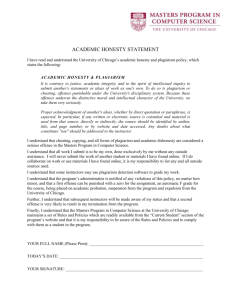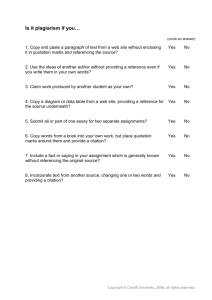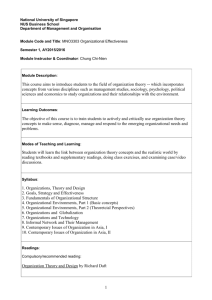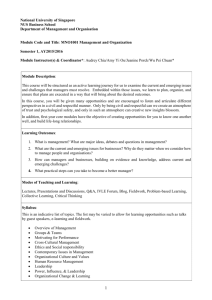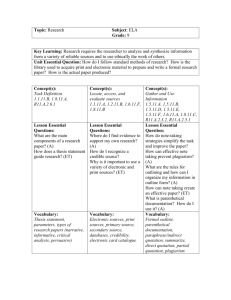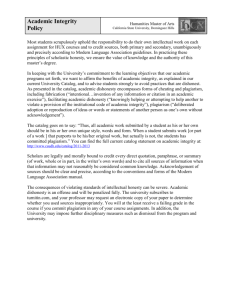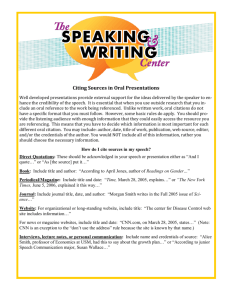What is the Academic Integrity Tutorial?
advertisement
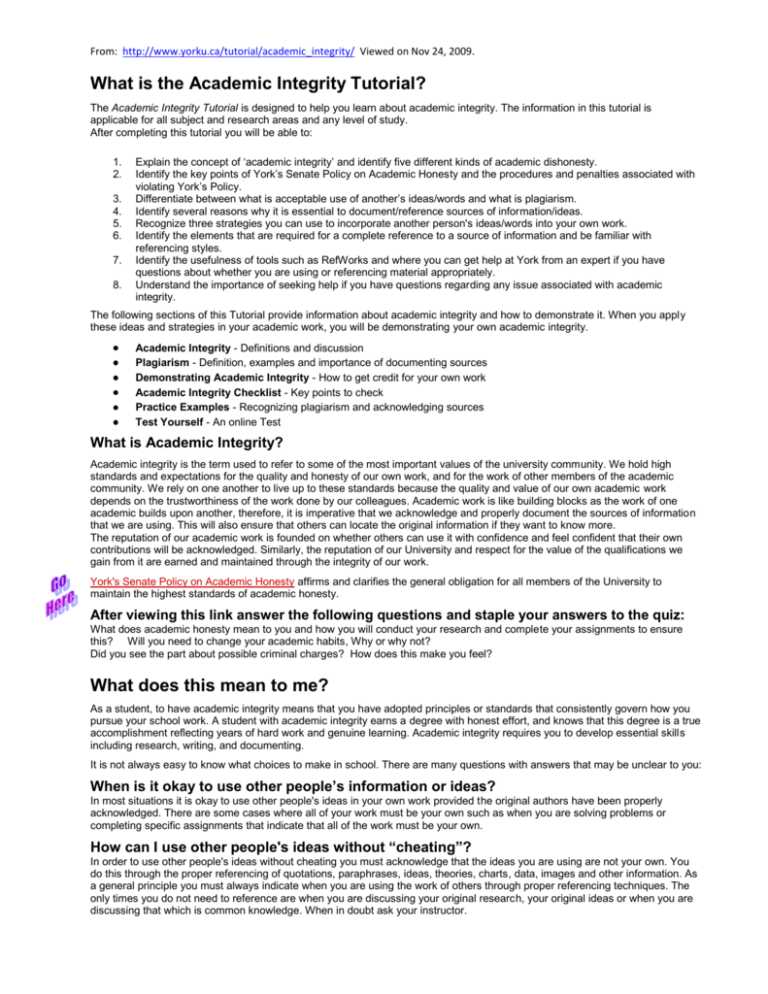
From: http://www.yorku.ca/tutorial/academic_integrity/ Viewed on Nov 24, 2009.
What is the Academic Integrity Tutorial?
The Academic Integrity Tutorial is designed to help you learn about academic integrity. The information in this tutorial is
applicable for all subject and research areas and any level of study.
After completing this tutorial you will be able to:
1.
2.
3.
4.
5.
6.
7.
8.
Explain the concept of „academic integrity‟ and identify five different kinds of academic dishonesty.
Identify the key points of York‟s Senate Policy on Academic Honesty and the procedures and penalties associated with
violating York‟s Policy.
Differentiate between what is acceptable use of another‟s ideas/words and what is plagiarism.
Identify several reasons why it is essential to document/reference sources of information/ideas.
Recognize three strategies you can use to incorporate another person's ideas/words into your own work.
Identify the elements that are required for a complete reference to a source of information and be familiar with
referencing styles.
Identify the usefulness of tools such as RefWorks and where you can get help at York from an expert if you have
questions about whether you are using or referencing material appropriately.
Understand the importance of seeking help if you have questions regarding any issue associated with academic
integrity.
The following sections of this Tutorial provide information about academic integrity and how to demonstrate it. When you apply
these ideas and strategies in your academic work, you will be demonstrating your own academic integrity.
Academic Integrity - Definitions and discussion
Plagiarism - Definition, examples and importance of documenting sources
Demonstrating Academic Integrity - How to get credit for your own work
Academic Integrity Checklist - Key points to check
Practice Examples - Recognizing plagiarism and acknowledging sources
Test Yourself - An online Test
What is Academic Integrity?
Academic integrity is the term used to refer to some of the most important values of the university community. We hold high
standards and expectations for the quality and honesty of our own work, and for the work of other members of the academic
community. We rely on one another to live up to these standards because the quality and value of our own academic work
depends on the trustworthiness of the work done by our colleagues. Academic work is like building blocks as the work of one
academic builds upon another, therefore, it is imperative that we acknowledge and properly document the sources of information
that we are using. This will also ensure that others can locate the original information if they want to know more.
The reputation of our academic work is founded on whether others can use it with confidence and feel confident that their own
contributions will be acknowledged. Similarly, the reputation of our University and respect for the value of the qualifications we
gain from it are earned and maintained through the integrity of our work.
York's Senate Policy on Academic Honesty affirms and clarifies the general obligation for all members of the University to
maintain the highest standards of academic honesty.
After viewing this link answer the following questions and staple your answers to the quiz:
What does academic honesty mean to you and how you will conduct your research and complete your assignments to ensure
this? Will you need to change your academic habits, Why or why not?
Did you see the part about possible criminal charges? How does this make you feel?
What does this mean to me?
As a student, to have academic integrity means that you have adopted principles or standards that consistently govern how you
pursue your school work. A student with academic integrity earns a degree with honest effort, and knows that this degree is a true
accomplishment reflecting years of hard work and genuine learning. Academic integrity requires you to develop essential skills
including research, writing, and documenting.
It is not always easy to know what choices to make in school. There are many questions with answers that may be unclear to you:
When is it okay to use other people’s information or ideas?
In most situations it is okay to use other people's ideas in your own work provided the original authors have been properly
acknowledged. There are some cases where all of your work must be your own such as when you are solving problems or
completing specific assignments that indicate that all of the work must be your own.
How can I use other people's ideas without “cheating”?
In order to use other people's ideas without cheating you must acknowledge that the ideas you are using are not your own. You
do this through the proper referencing of quotations, paraphrases, ideas, theories, charts, data, images and other information. As
a general principle you must always indicate when you are using the work of others through proper referencing techniques. The
only times you do not need to reference are when you are discussing your original research, your original ideas or when you are
discussing that which is common knowledge. When in doubt ask your instructor.
Can I use work I did last year in one of my courses this year?
Yes and no. You can use your work from previous years provided you clearly indicate what section(s) of your assignment, paper
or report was completed for an earlier course. Many students (and even academic professionals) use old research as a "jumpingoff" point for further inquiry. You must, however, have enough "new material" so that your current assignment, paper or report can
be counted for academic credit. Simply handing in an old assignment for evaluation in another course is not acceptable. If you are
going to reference previous academic work for an assignment in another course, always check with your instructor beforehand.
Can I share my answers/work/research with my friends?
Yes and no. You can work with other students when the professor has announced that it is acceptable to do so. Often professors
will encourage students to work in groups for specific projects. At all other times you must keep your work to yourself. This will
ensure that you are not helping others to copy or misuse your work. It is academic misconduct to encourage, enable or cause
others to commit a breach of academic honesty.
Forms of Academic Dishonesty
There are several other kinds of actions that are also considered offences against the standards of academic honesty. Among
these are cheating, impersonation, aiding and abetting, collusion and falsification and fabrication, defined as follows:
Cheating
Cheating is the attempt to gain an improper advantage in an academic evaluation. Some forms of cheating include getting a
copy of an exam or finding out an exam question before it is officially available; copying another person's answer to an exam
question; consulting an unauthorized source during an exam; submitting the work one has done for one class or project in a
second class; submitting work prepared in collaboration with other members of a class without authorization from the instructor;
submitting work prepared in whole or in part by another person and representing that work as one's own.
Impersonation
It is a breach of academic honesty to have someone impersonate one's self in class, in a test or examination, or in connection
with any other type of assignment in a course. Both the impersonator and the individual impersonated may be charged.
Aiding and Abetting
It is academic misconduct to encourage, enable or cause others to commit a breach of academic honesty. Anyone who
helps or enables another in cheating, impersonation, plagiarism, or any other breach of academic honesty will be subject to the
penalties outlined in York's policy. The giver need not be aware of the fact that the receiver will misuse the academic work. Simply
providing it enables the receiver to misuse it and thus maybe considered aiding and abetting. Examples of aiding and abetting
include sharing a lab report/formula/assignment/old exam/computer program with another student in person or electronically by
email or on a social networking site such as Facebook. Both the owner of the lab report/formula/assignment/old exam/computer
program and the person who copied maybe charged.
Collusion
There is a significant difference between collaboration and collusion. Collaboration is working jointly with others and is often
encouraged by course instructors. Collusion is working jointly with others when it is not permissible or when the instructor
does not authorize working in a group.
Permissible Collaboration includes:
Group work that clearly follows the course director's instructions
Sharing research findings or discussing course materials with other students when these contributions are fully
acknowledged in one's individual work
In contrast, collusion includes:
Working with another student on an assignment when working in groups has not been approved by the instructor.
Dividing sections of an assignment or project among a group and then presenting it as work having been completed
individually.
Splitting the tasks for group assignments unevenly where some students do most of the work while others do very little.
Fabrication and Falsification
It is a breach of academic honesty to fabricate (make-up) research or results. This includes: statistics, experimental results
or data, research methodology, facts, quotations, references or bibliographic material and research and the ideas of others.
It is also a violation of academic honesty to falsify information. This includes:
"Massaging" or dishonest reporting of research, lab results or data 1
Starting from expected results and working backwards 2
Misrepresenting the research and ideas of others 3
"Falsely reporting having met the responsibilities for a course, practicum or internship". 4
Falsifying one′s attendance in a course or fieldwork 5
"Falsifying letters of support or letters of reference
Falsifying academic records and transcripts
Misrepresenting the amount of work one has contributed to group assignments and activities" 6
Falsifying doctors′ notes or other documentation related to petitions or missed work
Modifying graded, returned material then submitting it for regrading
1
Wikipedia: The Free Encyclopedia, Fabrication (Science) URL:
http://en.wikipedia.org/wiki/Fabrication_%28science%29, retrieved March 20th, 2009.
2
Wikipedia: The Free Encyclopedia, Fabrication (Science) URL:
http://en.wikipedia.org/wiki/Fabrication_%28science%29, retrieved March 20th, 2009.
3
Brigham Young University, Honor Code, Fabrication or Falsification. URL:
http://honorcode.byu.edu/content/view/3565/, retrieved March 20th, 2009.
4
University of North Carolina Geensboro, Dean of Students, Academic Integrity. URL:
http://academicintegrity.uncg.edu/violation/falsify/ , retrieved March 20th, 2009.
5
University of North Carolina Geensboro, Dean of Students, Academic Integrity. URL:
http://academicintegrity.uncg.edu/violation/falsify/ , retrieved March 20th, 2009.
6
University of Guelph Undergraduate Degree Regulations and Proceedures, Academic Misconduct, Offences. 2008-2009 Undergraduate
Calendar, VIII. URL:
http://www.uoguelph.ca/registrar/calendars/undergraduate/current/c08/c08-amisconductoffen.shtml,
retrieved March 20th, 2009.
What is Plagiarism?
Plagiarism is representing someone else's ideas, writing or other intellectual property as your own, and is another form
of academic dishonesty.
Any use of the work of others, whether published, unpublished or posted electronically (e.g., on web sites), attributed or
anonymous, must include proper acknowledgement.
Common Types of Plagiarism
Plagiarism can take many forms. Some of the most common types of plagiarism include1:
Downloading or buying research papers (Downloading a free paper from a web site or paying to download a paper and
submitting it as your own work)
Copying and Pasting (copying and pasting portions of text from online journal articles or websites without proper
citation)
Copying or submitting someone else′s work (copying a paper/lab report/formula/design/computer
code/music/choreography/assignment etc. and submitting it as your own work)
1
Harris, R. A. (2002). The plagiarism handbook: Strategies for preventing, detecting, and dealing with plagiarism.
Los Angeles: Pyrczak Publishing, p. 13.
Why Document Your Sources?
It is very important to document your sources. Here are a few reasons why1:
1. Strengthens your work/writing
Citing a source through paraphrasing or quoting demonstrates that you have researched and incorporated your findings
into your own argument. You also demonstrate that you are aware of other academic opinions on the topic.
2. Documenting Sources Shows Respect for Intellectual Property
Citing shows respect for the creators of ideas and arguments honouring thinkers and their intellectual property.
3. Citing is a service to the Reader
Citing enables the reader to locate the sources of information and pursue further reading or investigation on the topic.
4. Serious Consequences if you do not Document your Sources
Any violation of academic honesty can result in serious consequences, ranging from a written disciplinary warning to
expulsion from the university, depending on the extent and nature of the offence.
Within the academic community plagiarism and other forms of academic dishonesty are seen as very serious offences, as
illustrated by the following statement:
It would be impossible to think of any greater insult to the integrity of an academic institution or to an academic community than
that of dishonesty whether it is called intellectual dishonesty or fraud. One can therefore sympathize with the desire to uncover it
and treat it with the condemnation it deserves when it is thought to exist.
Krever, J. in Hajee v. York University, 11 OAC 72, 1985
1
Harris, R. A. (2002). The plagiarism handbook: Strategies for preventing, detecting, and dealing with plagiarism. Los Angeles:
Pyrczak Publishing, p. 35.
Ultimately, if you weigh the risks and costs involved in submitting a plagiarized paper, you might consider it a far better
strategy to work on improving your research and writing skills to produce honest work. Why not take advantage of the
many resources available on campus and on the Internet to help you improve your academic skills?
Demonstrating Academic Integrity
When to Cite?
There are two basic rules:
1.
2.
If you directly use someone else′ s words, etc., use quotation marks and give a complete reference.
Give a complete reference if you use someone else's:
o Idea, theory or opinion
o Music, drawings, designs, dance, photography and other artistic or technical work
o Tables, graphs or any other graphic element
o Facts and information that are not generally known
o Unusual or distinctive phrases, specialized terms, computer codes, quantitative data
o Spoken or written words
Sources that Do Not Have to be Referenced
Your own ideas do not have to be referenced. Anything that you conclude from your research or that you think up on
your own counts as your own idea.
o The exception to this is work that you have previously submitted in any course in the past. This must
be referenced like any other source.
If your idea is similar to another author's, make it clear in your writing that you thought of this idea on your own, but you
later discovered it in another source (example: "Similar conclusions are found in.")
Common knowledge does not have to be referenced. If the information meets the following criteria, it can usually be
considered common knowledge:
o It appears in several sources without reference.
o It is not controversial. This means the information is generally considered as fact. (i.e. The earth orbits around
the Sun)
If it is part of your thesis or main arguments, or it is the basis of your research, it must be referenced. If you have any
doubts as to whether the information constitutes common knowledge, cite the source or consult your professor.
Incorporating another person's ideas and words into your work:
Direct Quotation: When incorporating another person's exact words into your work use a direct quotation. Be sure to place an
opening quotation (“) when beginning the quote and a closing quotation (”) when ending the quote.
Paraphrasing or Summarizing: A paraphrase or summary uses your own words and sentence structure to explain someone
else's idea or information obtained from another source (see example). You do not need to use quotation marks, however, you
must acknowledge the originating source in your work with a citation. Failing to acknowledge a paraphrase implies that the writing
represents your own original idea
How to Cite Right:
There are 2 elements needed to correctly document a source:
1. In your text: Whenever you quote, paraphrase, summarize, or otherwise refer to the work of another, you are required to cite
its source, either by way of parenthetical documentation (bibliographic information within parentheses) or by means of a
footnote/endnote (bibliographic information at the bottom of the page or at the end of the paper).
Example MLA style:
Human beings have been described as "symbol-using animals" (Burke 3).
**Note you can place the author′s name in the citation (as above) or directly in the text. This is called a signal phrase (see below).
Burke explains that human beings have been described as "symbol-using animals" (3).
Long quotations: Each reference style will have specific directions for direct quotations that are more than 3 or 4 lines. For
example, for APA and MLA styles the following rules apply:
In most cases, use a colon to introduce the quotation.
Indent the quotation one inch from the left margin.
Double-space the quotation.
Do not use quotation marks.
Place the parenthetical citation (author and page number) after the period (or other mark of punctuation) that closes the
block quotation.
2. In your Bibliography/Works Cited/Reference List: Most style manuals require you to assemble a list of the works that you
have cited in your paper. This list, included at the end of your paper, may be termed “Works Cited”, a “Reference List”, a
“Bibliography”, or some similar term.
Example APA style:
Fleming T. (1997). Liberty!: The American revolution. New York: Viking.
Important elements in your Bibliography/Works Cited/Reference List
There are essential pieces of information that a writer must provide about the articles, texts and other sources they have drawn
on. Some or all of them are necessary to uniquely identify and locate the original source, or to find similar materials.
Author, editor, Group/Association (name and initials)
Title of the work (where applicable)
Title of the book or journal where the work came from
Volume number (of a journal or series of books)
Publisher
Place of publication
Date of publication
Web page address (URL or DOI)
More information on how to cite resources and different style guides
See also: CitationMachine.com; easybib.com
Academic Integrity Checklist
In order to ensure that you have adhered to the university's policies regarding academic integrity please work through the
following checklist:
o I fully understand my instructor's requirements for group and individual assignments (when in doubt always ask).
o There is no section or component of my assignment, paper or research report that I do not understand (if you do not
understand your own work it is, therefore, not in your own words, and has been plagiarized).
o I have kept my research notes, lab-sheets, outlines and early drafts (you may be asked to provide these to your
instructor).
o My direct quotations have quotation marks (both opening and closing) and are fully referenced.
o All ideas used from other sources include citations.
o The reference entries in my bibliography/works cited/reference list corresponds with every idea/quote I have used.
o I have checked my work against my notes to be sure I have correctly referenced all direct quotes or borrowed ideas.
o Apart from material that is a direct quotation, everything else is in my own words.
o In paraphrasing the work from others I put the complete idea into my own words and did not just change a few words.
o I have checked all citations for accuracy (i.e. page numbers, dates, web page addresses).
o
o
o
o
o
I have asked an instructor/TA/Librarian about how to include any material I was unsure how to document.
I have used one recognized Reference Style (i.e. APA, MLA, Chicago etc.) consistently throughout my paper/work.
I have accurately and completely described any data or evidence I have collected.
I have kept my work to myself and did not share answers/content with others, unless otherwise directed by my
instructor.
This is the first time I have submitted this material for a course.
Examples: Modern Retail Trends
In this case, we will look at developing a paraphrase from an original source.
The Original Material:
During the 1990s, Canada began a major transformation from a predominantly young to a predominantly middle-aged society.
For that reason, retailing in Canada entered a new era of quality and service. In the years to come, stores that compete on the
basis of quality and service will have a much better chance of success than stores that compete solely on the basis of price.
Source: Foot, David K., with Daniel Stoffman. Boom, Bust & Echo 2000: Profiting from the Demographic Shift in the New
Millennium. Toronto: MacFarlane Walter & Ross, 1998. 109-110.
Writing Sample 1:
Over the past decade, Canada has started to change dramatically from a mainly young society to one that's middle-aged. As a
result, Canadian retail has entered a new age of quality and service. In the years to come, stores that compete on the basis of
quality and service will fare better than those based on lower prices.
Does this writing sample display academic integrity?
No. This example is a poor attempt at using Professor Foot's original passage without acknowledgement. In it, several words
and phrases are substituted by others—however, much of the original phrasing and organization remains the same, as
shown below. As it stands, the text appears to represent the writer's ideas rather than those of Professor Foot's and therefore is
plagiarism.
Substitutions are shown in {red text with curly brackets}. Original phrases are shown in [blue text with square brackets]. Note that
there is no citation at the end.
{Over the past decade}, Canada {has started to change dramatically} [from a] {mainly} young society to one that's middle-aged.
{As a result,} Canadian retail has [entered a new] {age} [of quality and service. In the years to come, stores that compete on the
basis of quality and service will] {fare better than} those based on lower prices (no citation!).
Writing Sample 2:
In his book, Boom, Bust & Echo 2000 (1998), David Foot observes that Canadian society is changing dramatically from a mainly
young society to one that's middle-aged. He predicts that this shift will alter the nature of retail as consumers are becoming more
interested in dealing with stores that offer quality products and service rather than those offering lower prices (109-110).
Does this writing sample display academic integrity?
Yes. In this example it is clear that the main idea and line of reasoning came from Professor Foot's research, and not the
writer's. The passage begins with a signal phrase to indicate that someone else's idea is being used, and ends with a citation so
that the reader can easily locate the original source of the information. In addition, the full reference of the source will be included
in the bibliography.
The signal phrase is shown in {green text with curly brackets}. The citation is shown in (blue text with parentheses).
{In his book, Boom, Bust & Echo 2000 (1998), David Foot observes} that Canadian society is changing dramatically from a
mainly young society to one that's middle-aged. He predicts that this shift will alter the nature of retail as consumers are becoming
more interested in dealing with stores that offer quality products and service rather than those offering lower prices (109-110).
Writing Sample 3:
Experts have been forecasting shifts in the Canadian retail market for some time now. David K. Foot, for example, predicted in
1998 that at the beginning of the new millennium bargain basement retailers are going to have a tougher time competing for their
market share than those that offer quality products. In his book, Boom, Bust and Echo, Professor Foot attributes this shift to the
fact that Canada is changing to a "predominantly middle-aged society" where the majority of consumers will favour quality and
service over price (109-110).
Yes. In this example, Professor Foot's ideas are used to illustrate a larger theme. The author and the source of the
information are provided as a context for the idea being discussed, and the reader can easily locate the original material.
Quotation marks are used around "predominantly middle-aged society," a phrase drawn directly from the original text. In this
example, as in the one above, the full citation will be included in the reference page at the end of the paper.
References to the author are shown here in {green text with curly brackets}. The source of the information is shown in [blue text
with square brackets], and in the citation in parentheses at the end. Note the direct quotation shown in red inside quotation marks.
Experts have been forecasting shifts in the Canadian retail market for some time now. {David K. Foot, for example, predicted
in 1998} that at the beginning of the new millennium bargain basement retailers are going to have a tougher time competing for
their market share than those that offer quality products. {In his book,} [Boom, Bust and Echo,] {Professor Foot} attributes
this shift to the fact that Canada is changing to a "predominantly middle-aged society" where the majority of consumers will
favour quality and service over price (109-110).
Test Yourself: An Overview
You've reached the end of the tutorial! On the next page, you will be given the link to the self-test—but first, let's review.
In this tutorial, we:
Discussed the concept of 'academic integrity' and identified five different kinds of academic dishonesty.
Identified the key points of York's Senate Policy on Academic Honesty and the procedures and penalties associated
with violating York's Policy.
Differentiated between what is acceptable use of another's ideas/words and what is plagiarism.
Identified several reasons why it is essential to document/reference sources of information/ideas.
Recognized three strategies you can use to incorporate another person's ideas/words into your own work.
Identified the elements that are required for a complete reference to a source of information and be familiar with
referencing styles.
Identified the usefulness of tools such as RefWorks and where you can get help at York from an expert if you have
questions about whether you are using or referencing material appropriately.
Underlined the importance of seeking help if you have questions regarding any issue associated with academic integrity.
Quiz instructions: Print and complete the quiz be sure to put your name on the top, staple the answers to
your questions to the back of the test and hand in to your teacher. Value: / 20
The Academic Integrity Quiz
Student Name: ______________________________________ Date: ____________________
Question 1: [1 mark]
Course XYZ has many assignments and lab reports. Although students are encouraged to discuss ideas with their
lab partners course work is to be completed independently.
Student X was writing a lab report and was running short on time. She had been rewording some ideas from web
materials and included this information in her report, however, she was rushed and didn′t save any of the URLs.
Her lab partner had talked about the results and together they decided to alter their results just a little to fit the
pattern they were expecting. To make sure that their lab reports were consistent they worked together and
submitted the exact same results section. Did student X demonstrate academic integrity?
No because she didn′t cite the web materials, changed the results, and submitted the same work as her
1.
partner.
2.
No because she didn′t cite the web materials, changed the results, and did the work in a rush.
Yes because she had to get the right lab results to get full marks and when you are in a hurry it is better to
3.
submit something than nothing at all.
Question 2: [1 mark]
In order to include a direct quote from another source in your writing you must:
1.
Cite its source, either by way of parenthetical documentation or by means of a footnote.
2.
3.
Cite its source and at the end of your work assemble a list of the works that you have cited in your paper.
Place quotation marks around the material that you are quoting, cite its source and include it in a list of
works at the end of your paper.
Question 3: [1 mark]
If you are not sure whether a particular course of action might result in academic misconduct the best thing to do
is:
1.
Go ahead with it as you are likely to be excused because you did not know what to do in the situation.
2.
3.
Talk to your professor, teaching assistant or a librarian to find out how to be sure to avoid academic
misconduct.
Go ahead with it because no one will notice because professors are very busy and have many papers to
mark.
Question 4: [1 mark]
What are the key points of York's Senate Policy on Academic Honesty?
States the general obligation for all members of the University to maintain the highest standards of
1.
academic honesty.
Defines the types of conduct that are regarded as academic offenses, including plagiarism, cheating,
2.
impersonation, and other forms of academic misconduct.
Outlines the procedures for dealing with students who are accused of academic dishonesty and the
3.
penalties that can be applied on those found guilty.
4.
All of the above.
Question 5: [1 mark]
Original Passage from the Book
Student Paper
The way in which men produce their means of
subsistence depends first of all on the nature of the
actual means they find in existence and have to
reproduce. This mode of production must not be
considered simply as being the reproduction of the
physical existence of the individuals. Rather it is a
definite form of activity of these individuals, a definite
form of expressing their life, a definite mode of life on
their part. As individuals express their life, so they are.
What they are, therefore, coincides with their
production, both with what they produce and with how
they produce. The nature of individuals thus depends on
the material conditions determining their production.
As individuals express their life, so they are write Karl
Marx and Friedrich Engels in The German Ideology (7).
While many of us would agree with this statement as a
matter of fact, we often do not make the association to
specific modes of production.
Bibliographic Information:
Karl Marx and Friedrich Engels. The German Ideology.
International Publishers: New York, 1947 (7).
Bibliography:
Karl Marx and Friedrich Engels. The German Ideology.
International Publishers: New York, 1947.
Did the student demonstrate academic integrity?
No, because it quotes another person′s actual words and credits the source but does not use quotation
1.
marks.
2.
Yes, because it quotes another person′s actual words using quotation marks and credits the source.
No, because the student has falsified information or misrepresented the author′s original position, theory
3.
or ideas.
Yes, because the author′s ideas, opinion or theory are used and put into the students′ words and are
4.
appropriately credited.
Question 6: [1 mark]
Student X was writing a paper on topic Y. He decided to try to find information on this topic and searched Google.
The first item that appeared in his list of results was an article from Wikipedia. While writing his paper Student X
would directly cut and paste paragraphs from the Wikipedia article into his paper without using quotations.
Did student X demonstrate academic integrity?
1.
2.
3.
4.
Yes, because Wikipedia articles have no author, therefore, anyone can use them.
Yes, because Wikipedia is like any other encyclopedia and contains only common knowledge so it is not
necessary to quote or give credit to the source.
No, because he plagiarized the material from Wikipedia and should have used quotation marks and cited
the source.
No, because he should have never used Wikipedia in the first place because it is not a reliable source.
Question 7: [1 mark]
Which of the following (fictitious) examples demonstrates plagiarism?
1.
According to Erin Lam (2001), fish swim much farther in clean water (28).
2.
87% of students who graduated from a Canadian University in 2005 found a job after graduation.
3.
"Happiness and chocolate are interdependent" (Plat, 1956, p. 42).
4.
Dag Feruzal (1999) writes, "It′s only in spring ... that you find the best snowdrops" (187).
5.
The sun rises in the East and sets in the West.
Question 8: [1 mark]
It was a course requirement to attend and review a performance of X. Tickets were expensive so a group of 4
students got together and decided that one of them would attend the performance and then would report back to
the group what they had seen through Facebook. Each member of the group then reworded the Facebook entry
and submitted the reviews as their own work.
Did these students demonstrate academic integrity?
1.
Yes, because they re-wrote the Facebook entry in their own words.
2.
3.
4.
Yes, because they worked as a group and professors encourage students to work together.
No, because they used Facebook to work as a group and professors don′t want students doing academic
work in Facebook.
No, because they colluded and fabricated a review of a performance they did not attend.
Question 9: [1 mark]
After the professor notices that the reviews are surprisingly similar. Would the student who attended the
performance and posted the review on Facebook be held responsible?
1.
Yes, because they had helped the other students in the group to violate academic integrity.
No, because they had done the work requested by the professor and they are not responsible for what
2.
the other students in the group submitted.
No, because anything written on Facebook is common knowledge and can, therefore, be shared or
3.
copied.
Question 10: [1 mark]
The purpose of documenting sources is to:
1.
Demonstrate that you have researched and incorporated your findings into your own argument.
2.
3.
4.
Show respect for intellectual property.
Enable the reader to locate the sources of information and pursue further reading or investigation on the
topic.
All of the above.

